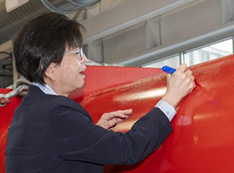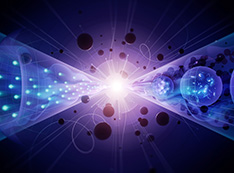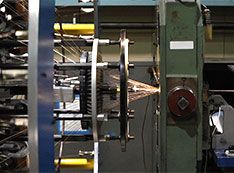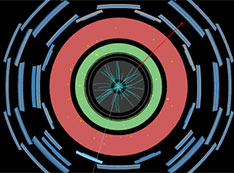Contact: Peter Genzer, (631) 344-3174 | Written by Kendra Snyder
The following news release is being distributed by CERN, the European laboratory for particle physics, about results presented today at the 2011 Quark Matter conference by three of the Large Hadron Collider’s (LHC) experimental collaborations. The ALICE, ATLAS, and CMS collaborations study lead ion collisions at LHC to learn more about a very hot, dense matter known as quark-gluon plasma — the properties of which were first measured at the Relativistic Heavy Ion Collider (RHIC) at the U.S. Department of Energy’s Brookhaven National Laboratory. Brookhaven scientists and engineers contributed significantly to a key part of the ATLAS detector system, known as the liquid argon calorimeter. In addition, Brookhaven physicist Peter Steinberg serves as the co-convener for the ATLAS heavy ion physics group, which is exploring “jet-quenching” — a phenomenon first observed at RHIC in 2003 (see related links below).
LHC Experiments Present New Results at Quark Matter 2011 Conference
May 23, 2011
Geneva — The three LHC experiments that study lead ion collisions all presented their latest results today at the annual Quark Matter conference, held this year in Annecy, France. The results are based on analysis of data collected during the last two weeks of the 2010 LHC run, when the LHC switched from protons to lead-ions. All experiments report highly subtle measurements, bringing heavy-ion physics into a new era of high precision studies.
“These results from the LHC lead ion program are already starting to bring new understanding of the primordial universe,” said CERN Director General Rolf Heuer. “The subtleties they are already seeing are very impressive.”
In its infancy, just microseconds after the Big Bang, the universe consisted of a plasma of quarks and gluons (QGP), the fundamental building blocks of matter. By colliding heavy ions, physicists can turn back time and recreate the conditions that existed back then, allowing us to understand the evolution of the early universe.
The LHC heavy-ion program builds on experiments conducted over a decade ago at CERN’s Super Proton Synchrotron (SPS) accelerator, which saw hints that the plasma could be created and studied in the laboratory. Then, in 1999, the baton passed to the Relativistic Heavy-Ion Collider (RHIC) at the US Brookhaven National laboratory, which firmly established that QGP could be created on a miniscule scale. This year’s Quark Matter conference is the first in the series to feature results from the LHC.
Results from the ALICE experiment have provided evidence that the matter created in lead ion collisions is the densest ever observed, over 100000 times hotter than the interior of the sun and denser than neutron stars. These conditions allow the properties of the plasma to be studied with unprecedented detail. ALICE has confirmed the RHIC experiments’ finding that QGP behaves almost like an ideal fluid with minimal viscosity. ALICE’s presentation also discussed the behavior of energetic particles in the QGP medium.
“We are very excited about the plethora of observables challenging many of the theoretical interpretations,” said ALICE spokesperson Paolo Giubellino. "The extraordinary capability of our detector to provide detailed information about the thousands of particles created in each collision proves to be essential for the understanding of the QGP.”
The ATLAS collaboration has performed a comprehensive study of heavy-ion collisions. The experiment’s analysis includes global properties, such as the number and distributions of charged particles emerging from the plasma, which elucidate the collision dynamics and transport properties of the medium, as well as so called hard-probes of the medium, which include measurements on the production of W and Z bosons, charmonium and particle jets.
“The first LHC heavy-ion run was a great success for ATLAS,” said co-convener of the collaboration’s heavy-ion group, Peter Steinberg of Brookhaven. “Combining global measurements and hard probes in LHC heavy-ion collisions is leading to greater insight into both the nature of the hot, dense medium and the QCD processes that lead to jet quenching.”
Jet quenching is the phenomenon, first reported by ATLAS last year, whereby so-called jets of particles formed in the collision are broken up as they cross the turbulent region of plasma.
CMS has seen a number of new phenomena including the production of W and Z bosons. Novel studies have been produced on jet quenching and to characterize the behavior of matter that reproduces the extreme conditions just after the universe’s birth. The most striking observation from CMS is that weakly bound states of the b-quark are heavily suppressed in lead-lead collisions. This phenomenon is important for understanding the properties of the QGP.
“We are entering a new era of high precision studies of strongly interacting matter at the highest energies ever,” said CMS spokesperson Guido Tonelli. “By deploying the full potential of the CMS detector we are producing unambiguous signatures of this new state of matter and unraveling many of its properties.”
Contact
CERN Press Office
press.office@cern.ch
+41 22 767 34 32
+41 22 767 21 41
2011-11285 | INT/EXT | Newsroom







